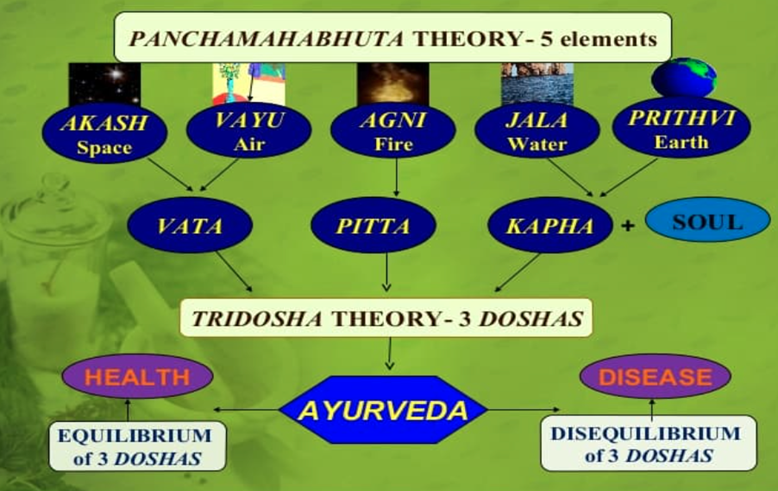Ayurveda is based on the ancient wisdom of PANCHAMABHUTA, Panch meaning five and bhuta meaning elements. This philosophy opines that all of the universe is made of 5 natural elements.
“Sarvam dravyam panchabouthikam” “Iti ha Dravyam Panchamahabhutatmakam”
(A. S. Su, 17/3)
Is a sanskrit proverb which roughly translates to “All material living or not, is made out of Panchamahabhutas”
These five elements constitute the structure of every material (material is further divided as dravya (matter) and sharira (physical body)).
Ayurveda recognizes the properties of a given substance based on its Mahabhuta dominance and helps you achieve balance.

According to the panchamahabhuta theory,
The five elements come together to constitute 3 doshas Vata, Pitta and Kapha. Ayurveda which is a medial approach based on this theory suggests that when there is an equilibrium of these 3 doshas you experience health and where is an imbalance it leads to disease.
You're only as healthy as your Gut.
The fire element of the body i.e. Agni rules the gut. Agni can also be referred to as an inner fire that looks after the process of energy transformation in humans. Agni plays a part in the metabolic function of our body and contributes to our ability to digest, absorb and assimilate food. The root cause of every disease comes down to a diminished functioning of Agni.
Ajeerna (Indigestion) leads to the formation of Ama, which means toxins in the body. Understanding The concept of Ama is key to achieving optimum health. Ayurveda is the only medical system which recognizes this toxin and addresses it directly. All types of ayurvedic treatments are geared towards the elimination of Ama.
So ama along with the doshas is the primary cause of dysfunction or disease in the body.
There are 4 types of agni as defined by the ancient texts, vishama agni, tikshna agni, manda agni, and sama agni.
The first 3 are harmful, and each related to a dosha that is out of balance. The goal is to achieve the fourth type of agni ie Sama Agni which leads to a balanced metabolism.
| SAMA Agni (Optimal Functioning Of Agni) | Mild Malfunction Of The Agni | Severe Malfunctioning Of Agni |
|---|---|---|
| Adequate diet | Loss of appetite | Insomnia |
| Timely evacuation of the bladder and bowels | Constipation and or diarrhea | Collection of fluid in body (Ascitis, edema etc) |
| Strength | Difficult micturition | Marked loss of energy and general debility |
| High immunity | Recurrent infection | Loss of enthusiasm |
| Proper skin texture and lustre | Lethargy | - |
| All sensory organs function well | Function of sensory organs diminished | - |
| - | depression | - |

Written By
Preventive Health and Wellness Specialist
Write a comment